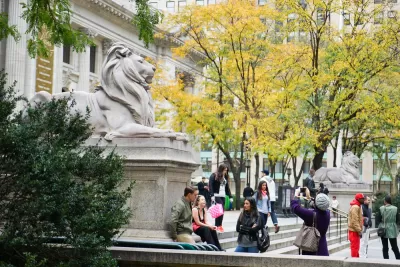More inclusive urban design can help more people access social services and public amenities.

Ishita Gaur describes how urban design can facilitate social services and improve equity in cities. “There are vast inequities in the distribution of healthcare, housing assistance, food accessibility, and educational opportunities, among others. While access to this social infrastructure is to a large extent driven by policy, certain spatial challenges exacerbate the situation—but they don’t have to.”
According to Gaur, “Physical and psychological barriers play a critical role in terms of providing access to vital social services for all. There is a stigma attached to social services, which, often keeps residents from availing of the benefits of such amenities.” Using New York City as an example, Gaur asserts that “The solution lies in creating a network of spaces that New Yorkers can approach for easy and non-judgmental access to the social services they need.”
The city should take this opportunity to not only broaden access to social amenities but also ensure that they are universally inclusive. Designing spaces that are welcoming to people of all income levels, employment statuses, age groups, and gender identities will be key to their success.
Gaur notes that “Inserting social services and amenities inside already welcoming and non-discriminatory spaces can dramatically reduce the perceived barriers that a person might need to overcome in seeking help. New services located at the exterior of these amenities can create a buffer space that receives people while also providing some privacy and anonymity to the individual seeking assistance.” For many people, “Even simple design decisions, such as the presence of a front desk or its location, can dramatically change the experience for an individual.”
As Gaur concludes, creating more inclusive and welcoming public spaces improves the health of cities as a whole. “Creating a healthier city for those most in need leads to a healthier city for all.”
FULL STORY: Op-ed: Social amenities can make space for social equity

Study: Maui’s Plan to Convert Vacation Rentals to Long-Term Housing Could Cause Nearly $1 Billion Economic Loss
The plan would reduce visitor accommodation by 25,% resulting in 1,900 jobs lost.

North Texas Transit Leaders Tout Benefits of TOD for Growing Region
At a summit focused on transit-oriented development, policymakers discussed how North Texas’ expanded light rail system can serve as a tool for economic growth.

Using Old Oil and Gas Wells for Green Energy Storage
Penn State researchers have found that repurposing abandoned oil and gas wells for geothermal-assisted compressed-air energy storage can boost efficiency, reduce environmental risks, and support clean energy and job transitions.

Santa Barbara Could Build Housing on County Land
County supervisors moved forward a proposal to build workforce housing on two county-owned parcels.

San Mateo Formally Opposes Freeway Project
The city council will send a letter to Caltrans urging the agency to reconsider a plan to expand the 101 through the city of San Mateo.

A Bronx Community Fights to Have its Voice Heard
After organizing and giving input for decades, the community around the Kingsbridge Armory might actually see it redeveloped — and they want to continue to have a say in how it goes.
Urban Design for Planners 1: Software Tools
This six-course series explores essential urban design concepts using open source software and equips planners with the tools they need to participate fully in the urban design process.
Planning for Universal Design
Learn the tools for implementing Universal Design in planning regulations.
Ascent Environmental
Borough of Carlisle
Institute for Housing and Urban Development Studies (IHS)
City of Grandview
Harvard GSD Executive Education
Toledo-Lucas County Plan Commissions
Salt Lake City
NYU Wagner Graduate School of Public Service





























